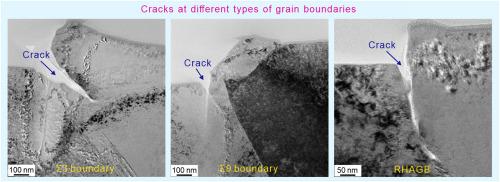高氮奥氏体不锈钢在空化腐蚀作用下不同晶界的开裂机理
IF 6.1
1区 工程技术
Q1 ENGINEERING, MECHANICAL
引用次数: 0
摘要
高氮奥氏体不锈钢具有良好的机械和化学性能,通常用于涉及高空化侵蚀(CE)风险的环境中。这些钢含有多种类型的晶界,具有不同的CE电阻。本研究对18Mn18Cr0.6N钢进行CE处理,并采用电子背散射衍射、聚焦离子束铣削和透射电镜对不同晶界处的裂纹进行了研究。发现阶梯形成是CE裂纹萌生的关键前提。Σ3边界处的台阶构造是由于晶粒旋转而形成的,这是由Σ3边界区域密集的层错和变形孪晶组成的狭窄变形带造成的。对于其他类型的晶界,如Σ9、Σ33c和随机的高角度晶界,由于晶界两侧晶粒的不协调变形而形成台阶。裂纹倾向于沿{111}面扩展;层错区域,如Σ3边界区和滑移带,是裂纹扩展的主要路径。CE裂纹难以横向穿过层错区。最后,分析了提高CE电阻的方法和影响层错形成的因素。本文章由计算机程序翻译,如有差异,请以英文原文为准。

Cracking mechanisms of different grain boundaries in a high-nitrogen austenitic stainless steel under cavitation erosion
High-nitrogen austenitic stainless steels exhibit beneficial mechanical and chemical properties and are often used in environments involving a high risk of cavitation erosion (CE). These steels contain many types of grain boundaries with various CE resistances. In this study, 18Mn18Cr0.6N steel was subjected to CE, and cracks at different grain boundaries were investigated by electron backscatter diffraction, focused ion beam milling, and transmission electron microscopy. Step formation was found to be a key prerequisite for the crack initiation in CE. The step formation at the Σ3 boundary is unique owing to grain rotation, which is caused by the narrow deformation band composed of dense stacking faults and deformation twins in the Σ3 boundary region. For other types of boundaries, such as Σ9, Σ33c, and random high-angle grain boundaries, steps form because of the uncoordinated deformation of grains on both sides of the boundary. Cracks are prone to propagate along {111} planes; stacking fault regions, such as the Σ3 boundary region and slip band, provide the major paths for crack propagation. CE cracks have difficulty passing through the stacking fault regions laterally. Finally, approaches aiming to improve the CE resistance and factors affecting stacking fault formation were considered herein.
求助全文
通过发布文献求助,成功后即可免费获取论文全文。
去求助
来源期刊

Wear
工程技术-材料科学:综合
CiteScore
8.80
自引率
8.00%
发文量
280
审稿时长
47 days
期刊介绍:
Wear journal is dedicated to the advancement of basic and applied knowledge concerning the nature of wear of materials. Broadly, topics of interest range from development of fundamental understanding of the mechanisms of wear to innovative solutions to practical engineering problems. Authors of experimental studies are expected to comment on the repeatability of the data, and whenever possible, conduct multiple measurements under similar testing conditions. Further, Wear embraces the highest standards of professional ethics, and the detection of matching content, either in written or graphical form, from other publications by the current authors or by others, may result in rejection.
 求助内容:
求助内容: 应助结果提醒方式:
应助结果提醒方式:


